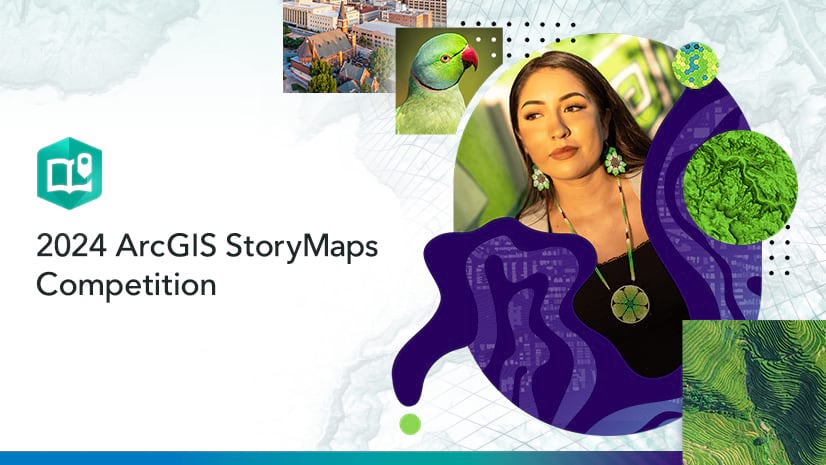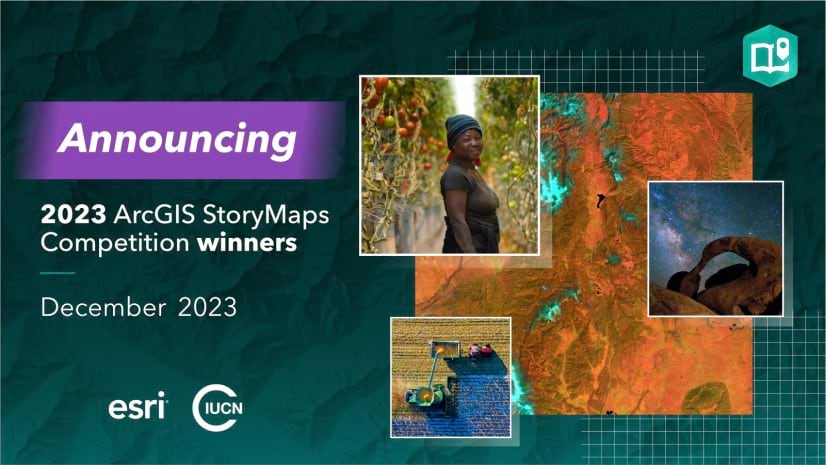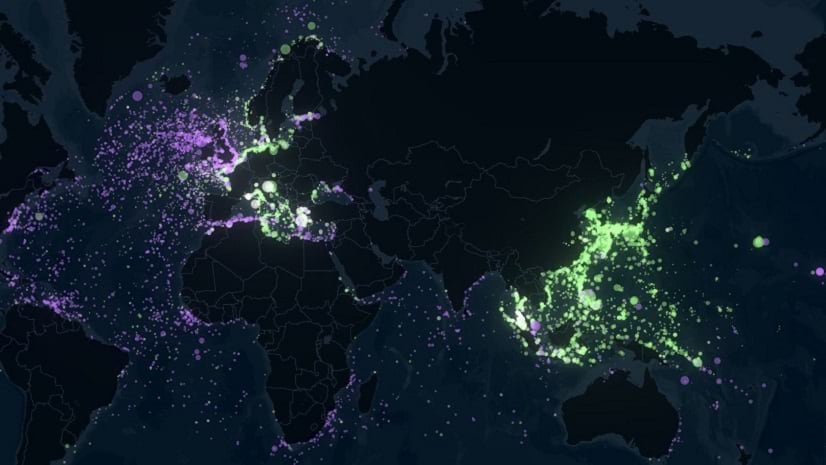The best thing about ArcGIS StoryMaps is that it provides an easy-to-use tool for telling stories about the world we live in — and the world we want to see. With three million stories published and counting, the impact that storytellers can have on a virtually infinite range of topics never fails to inspire us on Esri’s StoryMaps team.
Each year, the ArcGIS StoryMaps Competition encourages storytellers to submit their work and ultimately showcases some truly remarkable examples of how ArcGIS StoryMaps can be used to inform readers, achieve goals, and ultimately make the world a better place. We’re expecting the 2024 competition — now accepting submissions through December 6 — to be no exception.
If you’re even remotely thinking about tossing your hat into the ring, 1) do it! And 2) keep reading this blog post to get the lowdown on all you need to know before entering: The competition format, what the prizes are, and, perhaps most importantly, who will be determining the winners and what they’ll be looking for in a winning story.

How does the competition work?
Esri invites anyone who is at least 18 years old to submit one original story (that has not been submitted to a prior ArcGIS StoryMaps Competition) about the world we inhabit — and how that world can change for the better.
Entrants will be asked to submit their story under one of five categories:
- Nature and physical science
- Health and safety
- Humanitarian and disaster response
- Planning and infrastructure
- Digital humanities and popular culture
For more information on each of these categories and what they entail, plus resources to inspire you and help get you started, visit the Storytelling for a better world hub site.
Entrants who are enrolled in a two-year or four-year institution of higher education also have the option to have their story placed in a student track under each category so that their story will be judged against other student submissions.
Rules for submission (IMPORTANT!)
Although you’re probably excited to get your story submitted, it is critical to not overlook the basic submission requirements, including (but not limited to):
- Make sure you are using ArcGIS StoryMaps (not StoryMaps.com, which is a different product), and that you are not using a free public ArcGIS account to create your story.
- Make sure that your story — and all the content within it (web maps and the layers they contain, other ArcGIS apps, etc.) — are published publicly. Suddenly getting a login prompt while reading a story is a big no-no.
- If you’ve already submitted an entry to the 2024 ArcGIS StoryMaps competition, you may not submit another one (this applies to organizations that are submitting, as well as individuals/groups).
- If you’re submitting to the student track and worked on your submission with a group, all story authors must also be students.
For all the fine print, you can read the rules in full here. Not following any of the submission requirements can be grounds for an entry not being accepted, so it cannot be stressed enough how important it is to get these little things right the first time.

How do winners get selected and what do they get?
Esri’s StoryMaps team will review eligible submissions and select up to ten finalists and five student finalists in each of the five categories. Then, Esri has partnered with five organizations that will be responsible for determining a winner in both the main and student tracks for a particular category:
- Nature and physical science: International Union for the Conservation of Nature (IUCN)
- Health and safety: San Bernardino County Department of Public Health
- Humanitarian and disaster response: United Nations High Commissioner for Refugees (UNHCR)
- Planning and infrastructure: Old Dominion University Center for Geospatial Science, Education, and Analytics
- Digital humanities and popular culture: Stanford University Libraries Map and GIS Team
From those category winners, the judges will then choose one overall grand prize winner and one grand prize student winner.
On top of that, there will be two special awards:
- The Community Choice Award will be determined via public vote of the finalists; voting will occur from February 12, 2025 through March 12, 2025.
- The Storytelling With Maps Innovation Award will be selected by the StoryMaps team from among the finalists based on who we feel most demonstrates excellence and creativity in integrating other Esri GIS products and applications into their story.
All winners will receive an Esri certificate and social media badges, and will be interviewed and featured on the Esri website and social media platforms. The grand prize, Community Choice, and Storytelling with Maps Innovation winners will also receive an award at the 2025 Esri User Conference. Finally, the Storytelling with Maps Innovation Award winner is also eligible to receive a voucher (up to $250) for an Esri Technical Certification Exam.

What are the judges looking for?
And there it is, the million dollar question: What makes a story stand out amongst the hundreds of entries the ArcGIS StoryMaps competition typically receives? We’ve provided the judges with three deliberately broad criteria with which to examine each story:
- Overall design, impact, and originality
- Innovative use of GIS and the ArcGIS StoryMaps product
- Support of the competition and category theme
While we can’t speak for our judges and how they’ll ultimately approach their task, we can provide some advice and rules of thumb based on how we see the competition judging unfold year in and year out.
Overall design, impact, and originality
Be creative and thoughtful in your approach.
Whatever you’re covering in your story, we know you’re passionate about it, so let that passion shine through in a creative and memorable way. Remember that your audience likely doesn’t know nearly as much about the topic as you do, so take that into account as you’re constructing your narrative.
Sometimes, all it takes is an unorthodox approach to really pull readers in; Eroded Emerald, one of the student finalists from 2023, was told from the point-of-view of a green peafowl named Willy. Using first-person narration by a non-human character was unusual, but really stuck in our heads!
Don’t sleep on the visual language.
You could have an award-worthy story, full of impressive maps and GIS applications, with a captivating narrative to go along with them, but it may not make as much of an initial impression if the way the story looks is falling flat. We can tell when deliberate thought has been put into tying the story’s visual elements together in a cohesive way that adds to the overall storytelling experience, and it goes a long way toward elevating already-good stories.
It’s not coincidental that 16 of the 19 non-student finalists in 2023 used a custom theme to complement their story content. When rains fell in winter employs a stark, light theme and desaturated maps that evoke the tundra landscape where the story takes place. The City of Austin’s guide to tree canopy ties its theme to the infographics and maps that are used throughout the story, creating a seamless visual experience for readers.

Innovative use of GIS and the ArcGIS StoryMaps product
Show that you really know the story builder.
ArcGIS StoryMaps has not stopped growing as a product since it was released in 2019, with updates every few weeks to add more features and enhancements for storytellers to take advantage of. With so many options to choose from when building a story, however, it’s normal for some analysis paralysis to creep in. In our experience, the most exemplary stories all demonstrate that the storyteller has really gotten to know the ArcGIS StoryMaps builder.
And while it’s great to see all the different blocks put to good use, it’s clear when the use of those blocks has more of a “button-mashing” feel to it — throwing everything you can into a story just to prove that you can. It’s important to technically know how to use all the blocks, but it’s just as important to know when it makes the most sense to use each block in the context of your story. One of the 2023 competition runners-up, the story Living Territories only uses one block — sidecar — throughout the entire story. But the way those sidecar blocks are used creatively — floating vs. docked narrative panels, transparent narrative panels, map choreography, etc. — ensures that the story is immersive and engaging without ever feeling repetitive.
Integrate your GIS work — but be careful not to overwhelm.
We love when storytellers are excited to show off their GIS work in ArcGIS StoryMaps. It’s a big reason that the embed functionality exists, in fact, allowing you to easily pull other ArcGIS applications directly into a story. Dashboards, experience builder, and Survey123 are just a few of the ways you can augment a story with the power of GIS tools. But don’t lose sight of the purpose of your story; ask yourself, for instance, whether that Dashboard is going to actually help convey your key messages or whether it’s liable to be a distracting rabbit hole in the middle of the story.
One possible approach is to save your most in-depth GIS integration until near the end of the story. Let your audience dive as deep as they want into your data and outcomes, but only after they’ve read your whole story — and hopefully gained some important context that will only help them further understand an exploratory GIS element that might otherwise be overwhelming and disruptive to the flow of the story if placed earlier on. Another 2023 runner-up, Satellites and seeds, embeds a Dashboard as the final component of the story, ensuring that it won’t derail the story if a reader decides to stop and explore.

Support of the competition and category theme
Cross your T’s and dot your I’s.
For the most part, this should be the easiest category to get right. We believe that everyone — and every place — has a story to tell, and those stories together all make up the immense tapestry that is our world. Whichever thread in that tapestry is the one you want to pull, there’s more than enough room for it in the ArcGIS StoryMaps competition.
First and foremost, make sure you’re following the competition rules when you submit your story (outlined earlier in this post). But beyond that, also make sure that you have permission to use all of the content in your story if that content doesn’t belong to you. Use of copyrighted material without permission can be disqualifying, so leave those movie GIFs at the door.
Above all else…
…have fun!
If you’re looking for more inspiration and guidance on building an exemplary story, once again, the competition home page is a good place to start. There, you’ll find galleries of past winners so you can see the kinds of stories that have caught the judges’ attention in the past. You’ll also see a link to the hub site, which contains numerous resources that are specific to each category in the competition.
Be creative and enthusiastic, and we can’t wait to see your stories in the submission inbox soon!




Article Discussion: